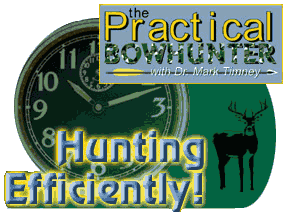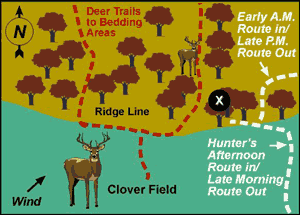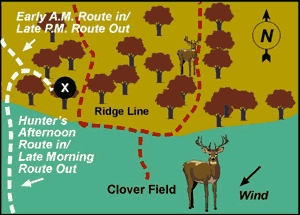
 By Dr. Mark Timney
By Dr. Mark Timney
How much time do you have to bowhunt? If youíre like me, you donít get to hunt as much as youíd like because of work, family, and other duties. But that doesnít mean you canít be a successful bowhunter.
In the past ten years Iíve averaged about 14 days afield each season. (And this only because of two trips out west for elk and week-long trips to Illinois and West Virginia for deer.) Yet despite my lack of time in the woods, I managed to harvest 28 deer and two elk. It ends up Iíve taken an animal for about every 18 hours in the field. How did I do it?
Luck had something to do with it, but more importantly Iím a very efficient bowhunter. And thatís what this Practical Bowhunter column is about: hunting efficiently. If youíre short on time, hunting efficiently makes a big difference as to whether or not youíll have meat for the freezer.
Shooting Well
While this column is about making the most of your hunting time, thereís one bit of time you canít short yourself on: shooting practice. You MUST set aside the time to learn to shoot your bow accurately, and to make sure your bow is set up properly.
If youíre not absolutely certain you can hit a deerís vitals (at your maximum range), then youíre wasting your time and hunting irresponsibly. And if you can extend your maximum range to 35 yards (which I feel is about the maximum range for a Ďhigh probabilityí shot at a whitetail by an experienced bowhunter), then youíve significantly increased your chance of filling your tag. That will only happen with practice.
While there isnít space to go into details about shooting a bow well here, keep in mind that Ďqualityí of practice is more important than Ďquantity.í To this end, I suggest that you find a good archery coach. One hour with a good coach is worth at least ten hours practicing alone. If your form is poor, the only thing youíre doing is practicing poor form.
Additionally, donít be tempted to take a low probability shot at a deer (a bad angle or a long shot) just because youíre short on time. You donít want to spend time afield looking for a wounded animal. Start right. Practice right. Shoot right in the field. It adds up to efficiency.
Deer Numbers
Hunt where there are LOTS of deer. I know. That sounds stupid. But too many bowhunters put themselves in a stand where they once saw a great buck instead of a stand where they usually see a number of does or lesser bucks. If youíre short on time, itís better to give up a little on deer quality for deer quantity. And, if you time your hunts right, such as during peak rut, youíll see good bucks where all the does are anyway.
Now, hunting where there are lots of deer might mean youíll have to drive a little further to hunt, or possibly even go out of state. But if this significantly increases the odds of your being successful in the time you have, then itís worth it.
Scouting
Scouting is a critical part of bowhunting. But what do you do if you donít have time to scout as much as you should? I rely on past scouting/hunting trips as much as I can, and I also see if other people can do some of my scouting for me.
Do you have a good stand site? If youíve been bowhunting for a while, you probably have at least one good place to hang a tree stand. Use it! I know a pear tree in West Virginia that Iím going to be perched in come October. I took two deer from it last year, and Iím certain Iíll take one or more from it this year. Half my scouting is already over!
Donít give up a good site to look for a better one when youíre short on time. And, while youíre sitting in that stand, or going to or from that stand, watch to see if thereís another nearby site to hang a treestand that looks to be more productive.
As to asking others about doing scouting for you.... This doesnít mean you should impose upon your buddies, although they may be willing to help out. What I mean by this is your asking the land owners where you hunt if theyíve seen deer. They probably have a good idea where deer are coming and going on their property. No sense for you to reinvent the wheel. I started hunting in the pear tree I mentioned because a land owner said heíd seen deer by it every night the week before the season opened. All I had to do was plan for getting to and from the site, hang a stand, and hunt it when the wind was right.
Multiple Stands
You need at least two tree stands, or a climbing stand, if youíre short on hunting time. You canít afford to miss a day just because the wind is blowing the wrong way for your favorite stand. Hang two stands in every area you hunt so you can hunt in any wind direction. And, donít forget that youíll often need a different stand for morning and evening hunts unless youíre set up in a neat travel corridor. This may mean youíll need at least four tree stands.
Stand Entry/Exit
The more you hunt a particular stand in a single season the worse your chances of taking a deer from it. Some expert bowhunters believe that tree stands and ground blinds can easily be "burnt out" in just a few hunts. This is because deer are far better at patterning hunters than we are patterning deer. This is bad news for those of use who have little time to be scouting and hanging new stands.
And with a wind shift:
I believe, however, that most stands get burnt out because hunters are careless about traveling to and from their stands. If you can sneak to and from your stand undetected, itís far more likely to stay fresher longer. For more info on this, read a previous Practical Bowhunter column on the subject, "Stealthy Stand Entries and Exits." It can be found at: Stealthy Stand Entries and Exits
Scent Control
I almost always wear scent control clothing when I donít have much time to hunt. The stuff works. While I prefer to play the wind as much as possible, I canít emphasize enough how
much difference these suits can make IF you de-scent the other items youíll be carrying with you outside the clothing. The suits also help you stay undetected as you travel to and from your stand.
Deer Calling
Bowhunting whitetails from a treestand is pretty much a waiting game. I believe you can o Ďspeed upí your waiting by deer calling, though. Calling has been very effective for me and I average at least one Ďcall-upí a day. And, if you use non-aggressive calling tactics youíre very unlikely to make sounds that will reduce your chances of taking a deer. For more on deer calling, see my first two Practical Bowhunter columns at: Deer Grunting
Have Faith
Youíve got to make maximum use of every minute in the field if you donít have much time to hunt. This means you should hunt in all types of weather (see my column on "Hunting Smart in Bad Weather), be in your stand early and leave late (conditions allowing), and not give up. You never know when a deer is going to show.
One final point.... A successful hunt doesnít have to end with your taking a deer. Some of my favorite hunts were the ones where I went home empty handed. So whatever you do, enjoy whatever time you have in the woods as much as possible. Thatís really what bowhunting is all about.
.
| Mark Timnney is a freelance writer and video producer from Kenne, NH. His articles have appeared in Bowsite.com since 1997. |

